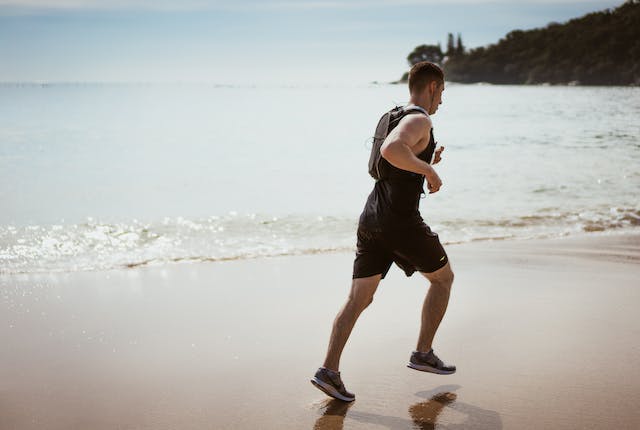
What is VO2 max? The V stands for volume, the O2 for oxygen, and the max for maximum. So, it is the maximum volume of oxygen your body is able to use during exercise.
We need oxygen all the time, obviously. If our oxygen supply is cut off, we will develop brain damage after a few minutes and die shortly after that as all our organs shut down. No oxygen, no life. However, when we exercise, we have to increase the amount of oxygen we take in.
Our muscles need energy to contract and that energy comes from a molecule called adenosine triphosphate (ATP). We can make ATP by breaking down carbohydrates, fats, and proteins. When we need to move our muscles, the ATP in our cells splits releasing a phosphate atom, and the energy that was used to attach that phosphate atom to the ATP can be used to fuel the muscle.
Our body has three different ways to make energy so we can move our muscles. The first type is called the Alactic Anaerobic System. This is the system we use when we need to make a very short movement. It can last for about ten seconds. Our muscles have a store of ATP inside them that we can access. When we need to move suddenly our bodies don’t have the time to create ATP, so they use the store they already have. These stores are not very big, which is why they only last about 10 seconds. The stores can be replenished after a few minutes of rest. This is called alactic because it doesn’t produce lactic acid and anaerobic because it doesn’t use oxygen.
The second system is called the Lactic Anaerobic System. This system switches on when the alactic system runs out of fuel. The body has realized that we need our muscles for longer than 10 seconds, for whatever reason, so it starts to make ATP from the glucose stored in the blood and the muscle. This can be done without oxygen, but it produces lactic acid in the muscles and blood as a byproduct. The lactic acid will build up to the point where it interferes with the system and we can’t produce ATP anymore. This is why your legs feel like lead if you sprint. The Lactic Anaerobic System can only last about 60 to 90 seconds.
If we need to keep using our muscles, the body switches to its third system, which is the aerobic system. The mitochondria in the muscle cells are able to make ATP from glycogen and fatty acids using enzymes, but they also need oxygen to do this. This system takes longer to get off the ground, but once it has started, it can continue for as long as there is glycogen and fatty acid in the body and a source of oxygen. In the process of producing ATP, the enzymes produce carbon dioxide and water as a byproduct. The carbon dioxide can build up to dangerous levels, and it has to be removed from the body. It is transmitted to the blood, then to the lungs, where it is expelled.
When we are at rest, most people breathe about 15 times a minute, taking in about 12 liters of air. When we start to exercise, our body goes through the two anaerobic systems and into the aerobic system. That requires oxygen and so our breathing has to speed up. If you have exercised, you will have noticed that you don’t breathe hard for the first couple of minutes. That is why. Once we move into the aerobic phase, we need more oxygen to feed the enzymes in the mitochondria and we need to breathe faster to remove all of the excess carbon dioxide from our muscles. The average person, depending on the intensity of the exercise, might start breathing 60 times a minute, which is about 100 liters of air.
Our VO2 max level is the maximum volume of oxygen that our muscles can use for energy. If someone is breathing in 100 liters of air a minute, they are breathing in about 20 liters of oxygen, but they are not using all of it. Our bodies are surprisingly inefficient and we only use about 5% of the oxygen we breathe in. However, some people are more efficient than others. Maybe they have a larger heart that can move more oxygen, or they have larger lungs which can take in more oxygen, or they have more efficient cells which can use more oxygen. Two people breathing in the same amount of oxygen will use differing amounts. And this is the VO2 max.
It is tested in a lab. People wear a face mask and exercise. The mask measures how much oxygen the person is breathing in and how much they are exhaling. The intensity of the exercise is increased until the oxygen consumption stops going up. The VO2 max can be calculated from that. At that point, if the exercise intensity is increased further, the body doesn’t have enough oxygen and has to move to the anaerobic system, which we cannot sustain for long. The higher someone’s VO2 max is, the more oxygen they are able to use and the more endurance they will have. They will not necessarily be faster, but they will be able to sustain a fast rate for longer. You can improve your VO2 through training, but at some point it comes down to genetics. And this is what I learned today.
Photo by Leandro Boogalu: https://www.pexels.com/photo/man-wearing-black-tank-top-and-running-on-seashore-1390403/
Sources
https://www.healthline.com/health/vo2-max#increasing-it
https://www.ncbi.nlm.nih.gov/pmc/articles/PMC4818249/
https://www.goodrx.com/well-being/movement-exercise/aerobic-vs-anaerobic-exercise
https://www.physio-pedia.com/Anaerobic_Exercise
https://www.triathlon.org/uploads/courses/54802/4-Energy-Training-Module_1.pdf
https://www.rei.com/learn/expert-advice/how-to-measure-and-improve-your-vo2-max.html
